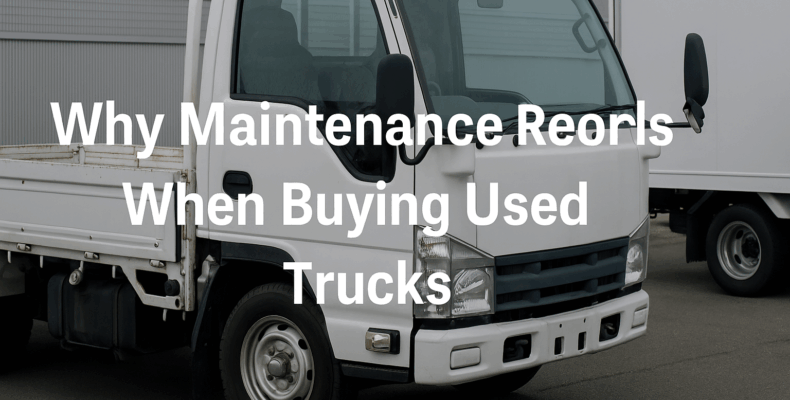When purchasing a Japanese used truck, buyers often focus on the engine condition, mileage, and bodywork. While these are critical, there’s another document that holds equal—if not greater—importance: the maintenance record.
This simple paper trail can be the key to securing a reliable vehicle and avoiding future headaches. Whether you’re buying from Africa, the Caribbean, Southeast Asia, or the Middle East, understanding maintenance history gives you confidence in your investment.
What Are Maintenance Records?
Maintenance records are documents that show the history of a truck’s upkeep. They include oil changes, part replacements, tire rotations, inspections, and repairs. Essentially, they tell the story of how well the previous owner cared for the truck.
Unlike just relying on visual inspections or mileage, these records offer transparent insight into the truck’s true condition.
6 Reasons Why Maintenance Records Are Essential
1. Reveal the Truck’s Real History
Even if a truck looks clean, it could have had engine problems in the past. Maintenance logs can show if those issues were professionally repaired.
2. Help You Avoid Hidden Problems
Without records, you risk buying a vehicle with untreated wear or delayed servicing. This often leads to costly repairs down the road.
3. Boost Resale Value
If you plan to sell the truck later, buyers will trust you more if you show a documented maintenance history. That can lead to a better price and quicker sale.
4. Support Smooth Registration
In many countries, customs and inspection authorities may ask for service documents. Having full records makes the process easier and faster.
5. Ensure Compatibility with Local Roads
Knowing which parts were replaced helps you plan future maintenance. This is especially useful if the truck will operate under different road or climate conditions.
6. Proof of Care from Japanese Owners
Japanese truck owners often follow routine maintenance strictly, especially under vehicle inspection laws. Having the paperwork proves this commitment to quality.
What to Look for in Japanese Maintenance Records
Not all documents are created equal. Here’s what makes a great record:
-
Service stamps from dealers or garages
-
Clear descriptions of parts replaced or inspected
-
Dates and mileage at time of service
-
Owner’s manual entries with handwritten notes
Most trucks exported from Japan include these records. However, it’s wise to confirm with your exporter before finalizing the purchase.
Can You Trust a Truck Without Records?
Yes, sometimes. But you must inspect the truck more carefully. Look for:
-
Oil residue near engine seals
-
Uneven tire wear
-
Delayed acceleration
-
Engine warning lights
While a truck without records can still be good, having clear documentation greatly reduces risk—especially for first-time buyers.
Ask Before You Buy
Reputable exporters understand how valuable records are. So, don’t hesitate to ask:
-
“Can you send photos of the maintenance book?”
-
“When was the last oil change or filter replacement?”
-
“Is the timing belt or clutch new?”
These simple questions can reveal how well the truck was maintained in Japan.
Start with a Trusted Exporter
Finding a supplier that values transparency is step one. We recommend this list to begin your search:
👉 Top 5 Trusted Japanese Used Truck Exporters for Global Buyers
They offer excellent support and often provide scanned maintenance documents before shipping.
Final Thoughts
Used trucks from Japan are reliable, but maintenance records tell the full story. They help you understand the truck’s past, predict its future, and make informed decisions.
So, the next time you spot a great-looking truck, don’t forget to ask:
“Where are the records?”
Reliable trucks come with reliable history. Choose smart, buy confidently, and drive without regrets.
